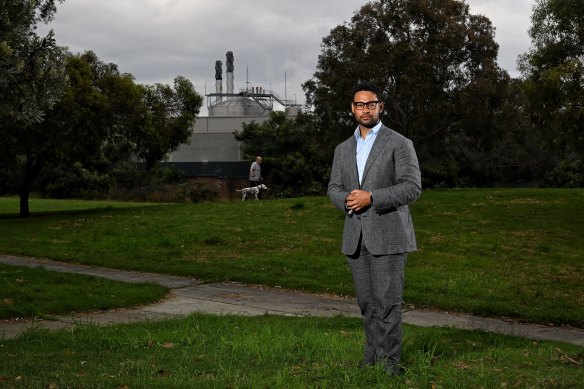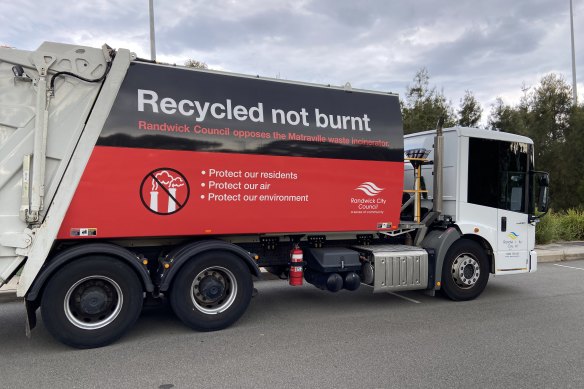This was published 3 years ago
‘Dog of a project’: Backlash grows against proposed waste incinerator
A Sydney council has covered a garbage truck with protest signs to pressure a French company to withdraw plans to build a waste incinerator close to a residential area.
“Randwick Council opposes the Matraville waste incinerator” reads a message on the side of a garbage truck alongside a picture of two smokestacks with a line through them.

Randwick mayor Dylan Parker said the Matraville incinerator was a “dog of a project”.Credit: Nick Moir
“The Matraville incinerator is a dog of a project and the community has known it from day one,” Randwick Labor mayor Dylan Parker said. “Burning waste metres from people’s backyards is just totally inconceivable in the 21st century.”
The council has lobbied the proponent to withdraw the incinerator plan and plans to fly banners with the anti-incinerator message.
“We won’t stop fighting until this dreadful proposal has either been withdrawn or refused,” Cr Parker said.
The $250 million incinerator, or Botany Cogeneration Plant, is designed to use 165,000 tonnes of waste each year that would otherwise be landfill and convert it into energy to power the Opal Paper and Recycling Mill in Matraville, reducing its reliance on gas.

A garbage truck emblazoned with an anti-incinerator message.Credit: Randwick City Council
A spokesman for French environmental services company Veolia said the project would meet and exceed stringent regulations on air emissions: “Energy recovery is a superior, sustainable solution to landfilling non-recyclable waste, moving the community further up the waste hierarchy.”
But Michael Daley, Labor member for Maroubra, said the project would replace a source of energy with a dirtier source of energy “so environmentally we say it doesn’t stack up”.
Mr Daley and Matt Thistlethwaite, federal Labor member for Kingsford Smith, have also raised concerns that the project would generate more truck and vehicle traffic in the area.
“The plant and 60-metre high (18-storey) vent stack will be built just 130 metres from homes in our community and operate 24 hours a day, 7 days a week,” Mr Thistlethwaite said.
The Veolia spokesman said the incinerator would help address Australia’s “urgent waste disposal needs”.
“Australians are among the highest producers of waste in the world and landfill more than most countries, despite the existence of safe, reliable and modern technology available to reduce waste and recover energy value,” he said.
However, the project is on hold until the state government finalises its draft Energy from Waste Amendment regulation following public consultation.
A NSW Environment Protection Authority spokesman said the draft regulation would limit energy from waste to four areas in regional NSW, including Lithgow, Goulburn and Richmond Valley in northern NSW.
Otherwise, he said energy from waste would only be permitted if the facilities use waste or waste-derived feedstock to replace less environmentally sound fuels - including coal or petroleum-based fuels - to generate energy.
“That energy can only be used to power industrial or manufacturing processes on-site, and cannot be exported to the grid,” he said.
Jon Beves, spokesman for the community-based No More Incinerators, said the proposed incinerator would produce highly toxic and persistent solid waste, contribute to greenhouse gas emissions and discourage recycling.
“Releasing toxic gas and particles into the air around residential areas will have a significant long-term impact on the health of residents of our suburbs and the rest of Sydney,” he said.
Randwick Greens deputy mayor Kym Chapple said residents were scared because of the proposed incinerator.
“The people of Matraville have long put up with heavy industry and a working port on their doorstep,” she said. “But putting an incinerator in their backyard is too much and people are genuinely scared for their health and that of their children.”
Dr Beves, who is also an associate professor of chemistry at the University of NSW, said the draft EPA regulation could allow the incinerator to be built.
“If the incinerator is approved it will act as a significant precedent for construction of similar incinerators at any other site around our city,” he said.
However, the EPA spokesman said changes to NSW laws restricting energy from waste to four areas in regional NSW would apply to any proposal not already approved and in operation, including state significant developments.
A guide to the environment, what’s happening to it, what’s being done about it and what it means for the future. Sign up to our fortnightly Environment newsletter here.